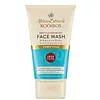What's inside
What's inside
 Key Ingredients
Key Ingredients

No key ingredients
 Benefits
Benefits

 Concerns
Concerns

 Ingredients Side-by-side
Ingredients Side-by-side

Water
Skin ConditioningGlycerin
HumectantCoco-Betaine
CleansingCoco-Glucoside
CleansingGlyceryl Glucoside
HumectantAcrylates/C10-30 Alkyl Acrylate Crosspolymer
Emulsion StabilisingSodium Chloride
MaskingPEG-40 Hydrogenated Castor Oil
EmulsifyingSodium Benzoate
MaskingTrisodium EDTA
Rosa Damascena Flower Water
MaskingPotassium Sorbate
PreservativeSorbic Acid
PreservativeLinalool
PerfumingCitronellol
PerfumingGeraniol
PerfumingLimonene
PerfumingMethyl Benzoate
PerfumingParfum
MaskingWater, Glycerin, Coco-Betaine, Coco-Glucoside, Glyceryl Glucoside, Acrylates/C10-30 Alkyl Acrylate Crosspolymer, Sodium Chloride, PEG-40 Hydrogenated Castor Oil, Sodium Benzoate, Trisodium EDTA, Rosa Damascena Flower Water, Potassium Sorbate, Sorbic Acid, Linalool, Citronellol, Geraniol, Limonene, Methyl Benzoate, Parfum
Water
Skin ConditioningSodium Laureth Sulfate
CleansingCocamide DEA
EmulsifyingCocamidopropyl Betaine
CleansingSorbitol
HumectantSodium Chloride
MaskingDecyl Glucoside
CleansingPEG-120 Methyl Glucose Dioleate
EmulsifyingAdansonia Digitata Fruit Extract
EmollientAspalathus Linearis Leaf Extract
Skin ConditioningCitric Acid
BufferingLaureth-4
EmulsifyingDisodium EDTA
Cocamidopropyl Dimethylamine
EmulsifyingSalicylic Acid
MaskingPhenoxyethanol
PreservativeCaprylyl Glycol
EmollientSodium Hydroxide
BufferingSodium Metabisulfite
AntioxidantParfum
MaskingAlpha-Isomethyl Ionone
PerfumingLimonene
PerfumingLinalool
PerfumingWater, Sodium Laureth Sulfate, Cocamide DEA, Cocamidopropyl Betaine, Sorbitol, Sodium Chloride, Decyl Glucoside, PEG-120 Methyl Glucose Dioleate, Adansonia Digitata Fruit Extract, Aspalathus Linearis Leaf Extract, Citric Acid, Laureth-4, Disodium EDTA, Cocamidopropyl Dimethylamine, Salicylic Acid, Phenoxyethanol, Caprylyl Glycol, Sodium Hydroxide, Sodium Metabisulfite, Parfum, Alpha-Isomethyl Ionone, Limonene, Linalool
Ingredients Explained
These ingredients are found in both products.
Ingredients higher up in an ingredient list are typically present in a larger amount.
Limonene is a fragrance that adds scent and taste to a formulation.
It's found in the peel oil of citrus fruits and other plants such as lavender and eucalyptus. The scent of limonene is generally described as "sweet citrus".
Limonene acts as an antioxidant, meaning it helps neutralize free radicals.
When exposed to air, oxidized limonene may sensitize the skin. Because of this, limonene is often avoided by people with sensitive skin.
The term 'fragrance' is not regulated in many countries. In many cases, it is up to the brand to define this term. For instance, many brands choose to label themselves as "fragrance-free" because they are not using synthetic fragrances. However, their products may still contain ingredients such as essential oils that are considered a fragrance.
Learn more about LimoneneLinalool is a fragrance and helps add scent to products. It's derived from common plants such as cinnamon, mint, citrus, and lavender.
Like Limonene, this ingredient oxidizes when exposed to air. Oxidized linalool can cause allergies and skin sensitivity.
This ingredient has a scent that is floral, spicy tropical, and citrus-like.
Learn more about LinaloolParfum is a catch-all term for an ingredient or more that is used to give a scent to products.
Also called "fragrance", this ingredient can be a blend of hundreds of chemicals or plant oils. This means every product with "fragrance" or "parfum" in the ingredients list is a different mixture.
For instance, Habanolide is a proprietary trade name for a specific aroma chemical. When used as a fragrance ingredient in cosmetics, most aroma chemicals fall under the broad labeling category of “FRAGRANCE” or “PARFUM” according to EU and US regulations.
The term 'parfum' or 'fragrance' is not regulated in many countries. In many cases, it is up to the brand to define this term.
For instance, many brands choose to label themselves as "fragrance-free" because they are not using synthetic fragrances. However, their products may still contain ingredients such as essential oils that are considered a fragrance by INCI standards.
One example is Calendula flower extract. Calendula is an essential oil that still imparts a scent or 'fragrance'.
Depending on the blend, the ingredients in the mixture can cause allergies and sensitivities on the skin. Some ingredients that are known EU allergens include linalool and citronellol.
Parfum can also be used to mask or cover an unpleasant scent.
The bottom line is: not all fragrances/parfum/ingredients are created equally. If you are worried about fragrances, we recommend taking a closer look at an ingredient. And of course, we always recommend speaking with a professional.
Learn more about ParfumChances are, you eat sodium chloride every day. Sodium Chloride is also known as table salt.
This ingredient has many purposes in skincare: thickener, emulsifier, and exfoliator.
You'll most likely find this ingredient in cleansers where it is used to create a gel-like texture. As an emulsifier, it also prevents ingredients from separating.
There is much debate on whether this ingredient is comedogenic. The short answer - comedogenic ratings don't tell the whole story. Learn more about comegodenic ratings here.
The concensus about this ingredient causing acne seems to be divided. Research is needed to understand if this ingredient does cause acne.
Scrubs may use salt as the primary exfoliating ingredient.
Learn more about Sodium ChlorideWater. It's the most common cosmetic ingredient of all. You'll usually see it at the top of ingredient lists, meaning that it makes up the largest part of the product.
So why is it so popular? Water most often acts as a solvent - this means that it helps dissolve other ingredients into the formulation.
You'll also recognize water as that liquid we all need to stay alive. If you see this, drink a glass of water. Stay hydrated!
Learn more about Water